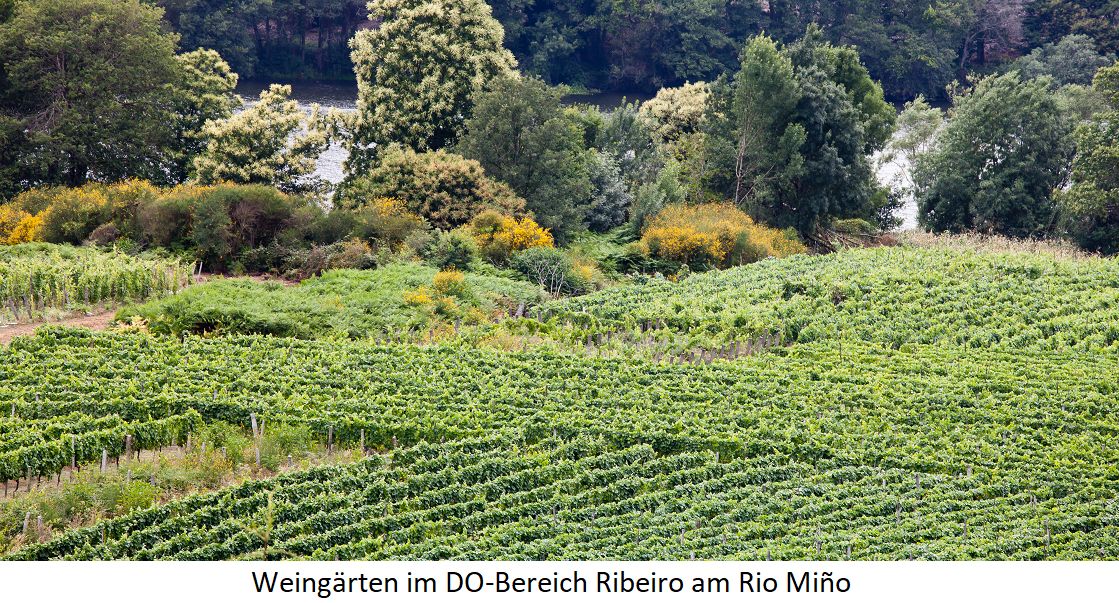Results
2,284 Results
Loading more Results ...
Loading more Results ...
Wine regions in Galicia 9 growing regions
Description to Galicia
Autonomous region or historical landscape of Spain with around 30,000 km² in the northwest of the Iberian peninsula, stretching along the Atlantic coast. The region borders Portugal to the south and the Basque Country to the east, with which Galicia belongs to the "green Spain". Separated from Castile-León by high mountains, development has been influenced by Portugal. The original inhabitants were the Celts (Galicians = from Gaul) in the west and the Basques in the east. In the 5th century the Germanic Swebs invaded and in 585 the Visigoths conquered it. After the liberation from Moorish rule in the 8th century, it first belonged to the Kingdom of Asturias, later to Castile-León. At the time of the independent Kingdom of Asturias, Santiago de Compostela (the end point of the famous pilgrimage route) was the capital.
History
The wine-growing tradition dates back to the Romans. The predominant white wine variety here, Albariño (Alvarinho), is said to have been introduced as early as the 12th century by the Cistercian monks of the monastery of Armenteira in the province of Pontevedra. In the 14th century, wine was exported to many European countries. In the 19th century, the phylloxera disaster destroyed a large part of the vineyards in Galicia. The world wars and an economic crisis had a negative impact on viticulture, which only slowly recovered after joining the EU in 1986.

Climate & Soils
The mountainous country is intersected by countless rivers with many valleys and is therefore also known as the "Land of 1,000 Rivers". These include the Río Anllóns, Río Arnoia, Río Eo, Río Eume, Río Limoa, Río Miño, Río Sil and Río Tambre. The Atlantic climate is characterised by mild winters and moderately warm summers with high rainfall. The area is one of the most humid in Spain. Due to the many sunny days, it is therefore excellently suited for viticulture.
Vineyards & Grape Varieties
The vineyards cover around 10,000 hectares of vineyards on predominantly mineral-rich slate weathered and granite soils. They are located mainly in the south on the Portuguese border, preferably near the many positively flowing rivers. Significant for the region are the extremely high yields. White wine varieties occupy two thirds of the area, the most important being Albariño (Alvarinho), Godello, Loureira (Loureiro), Treixadura (Trajadura) and Palomino. The most important red wine varieties are Mencía, Garnacha Tinta, Tintorera (Alicante Henri Bouschet) and Bastardo (Graciano).
Wine growing areas
There are 5 DO areas (quality wines) and four IGP areas (country wines):
- Barbanza e Iria (IGP)
- Betanzos (IGP)
- Monterrei (DO)
- Rías Baixas (DO)
- Ribeira Sacra (DO)
- Ribeiras do Morazzo (IGP)
- Ribeiro (DO)
- Valdeorras (DO)
- Valle del Miño-Ourense/Val do Miño-Ourense (IGP)
Image: By Lmbuga (Luis Miguel Bugallo Sánchez) - Own work, CC BY-SA 3.0, Link
Classified wine producers in Galicia 5
find+buy for Galicia 35
Recent wines 182
 Bodegas Forjas del Salnés
— Galicia
2016 D.O. Rías Baixas Goliardo
Up to 30.00 €
Bodegas Forjas del Salnés
— Galicia
2016 D.O. Rías Baixas Goliardo
Up to 30.00 €

 Eulogio Pomares Zarate
— Galicia
2019 D.O. Rías Baixas "Balado"
Up to 30.00 €
Eulogio Pomares Zarate
— Galicia
2019 D.O. Rías Baixas "Balado"
Up to 30.00 €

The most important grape varieties
More information in the magazine
- The collections and discoveries of the year Tasting season 2023/2024
- Our wine tips for the barbecue: From the Wachau to the Priorat Currently tasted
- Paradisiacal times! Tasting: European sparkling wines for the festive season
- Elegant balance between extremes In FocusDO Rueda
- Turnkey vineyards for the holiday finca Interview: Mallorca winemaker Henri Fink
- "Sustainability is part of our family's DNA" Vicky Gonzalez-Gordon of Gonzalez Byass on wine and sherry in climate change
- Montsant More radiant with every step
- The terroir of the Montsant Rocks, mountains and gentle river valleys in the south
- History of viticulture in the Montsant Of Roman amphorae, phylloxera and wine cathedrals
- Discover Montsant Enjoy wine, experience nature, experience culture

